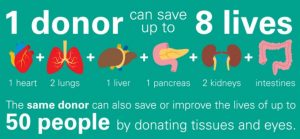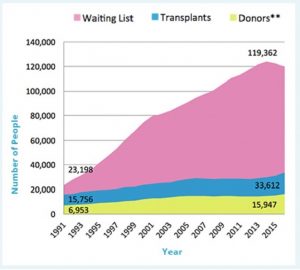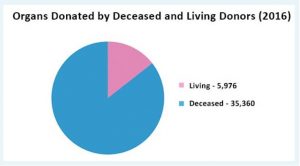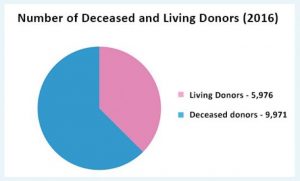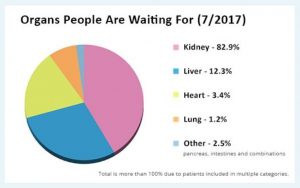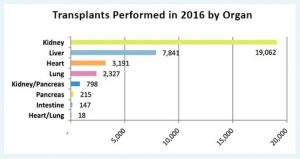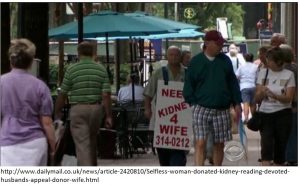You, or anyone you know would need to have an organ transplant, would be one out of those 116,000 individuals from the US national transplant waiting list. In fact, 10 people are added to the list in every single minute.
Despite improvements in the organ registration systems and in education by means of social campaigns to increase awareness, the gap between the number of organs available and the demand for them is increasing, and must be filled. Only 3 out of 1,000 people die in a way that allows for organ donation. At the same time, only 54% of people signed up as donors in the USA, while 95% of them support organ donation according to the statistics.
The following graphs summarize them all.
Donor Statistics (2016)
A total of 41,335 organs were donated in the US. More than 4 out of 5 donations came from deceased donors, and 1 out of 5 donations from living donors.
Nearly 6 in 10 donors are deceased and about 4 out of 10 are living donors.
Waiting List Statistics (2017)
Nearly 2 out of every 3 people on the waiting list are over the age of 50, and almost 2,000 are children under 18. In 2016, about 62% of organ recipients were male; 38% female. Quite an interesting fact is that the demand for kidneys massively dominates.
Transplantation Statistics (2016)
33,611 transplants were performed in 2016 – a new record the highest of four consecutive years. Each day, about 80 people receive organ transplants.
And now let us cover some unbelievable transplantation stories: 78-year-old Larry Swilling, dedicated to find a kidney for his wife, spent over a year walking the streets of Anderson, South Carolina, with a sandwich board appealing for donors. He got several calls and finally Kelly Weaverling, a retired navy lieutenant commander, proved to be a match. “I knew it was going to happen … he would not have stopped until he got me one “ said Mrs Swilling having undergone a successful operation.
Their extraordinary story inspired many, among others Wayne Winters from Utah, who again managed to find a kidney-donor for his wife upon marching miles every day, for over two years, with quite a similar sandwich board.
Somewhat less inspiring that a prominent surgeon and Cornell graduate, who gave his wife his kidney when she suffered renal failure, demanded her to return the organ – or pay $1.5million in compensation, upon their nasty divorce. Quite soon the court rejected the bizarre request…
Finally, let us finish with a cheerful story of Martin Warburton, a football fan who in return for his generous donation made his brother sign an agreement saying that he would stop rooting for his arch-rival football team. His brother Paul, fighting leukaemia, had the life-saving stem-cell transplant. After that he admitted his mixed feelings toward the contract. (They are still in good relation.)
We all need a good story to tell so we hope you have found at least one to share. Just don’t forget that the core message of this blogpost was: One Donor Can Save 8 Lives.
By Dorottya M Berki, PhD Internal Support Scientist
Data on organ shortage in Europe is quite comparable. We will soon cover the statistics and the European organ donation system in our forthcoming blogpost.
References:
Statistics – U.S. Department of Health & Human Services:
organdonor.gov
optn.transplant.hrsa.gov
Statistics – The Council of Europe Office in Pristina:
European Day for Organ Donation and Transplantation
https://nypost.com/2017/11/08/man-who-walked-miles-to-find-wife-a-kidney-donor-finds-match/
https://www.theguardian.com/commentisfree/cifamerica/2009/jan/15/richard-batista-divorce-kidney
http://www.dailymail.co.uk/news/article-1109122/Give-kidney-1-5m-surgeon-demands-estranged-wife.html
http://news.bbc.co.uk/sport2/hi/funny_old_game/3246472.stm
Do you want to sign up to be a donor in the US? CLICK HERE

